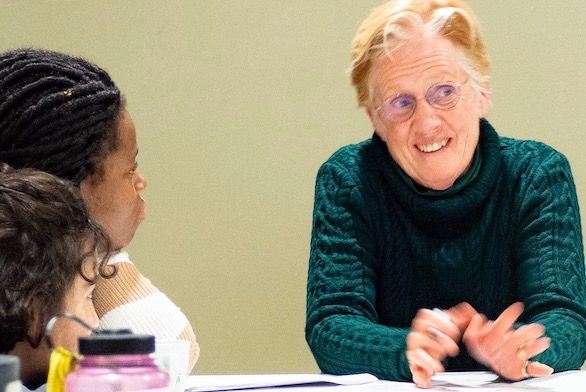The Great Conversation Goes Global
January 19, 2021 | By Eve Tolpa

For Santa Fe tutor Martha Franks, the great conversation that forms the bedrock of a St. John’s education is too good to keep on campus. Between 2012 and 2014, Franks, along with her husband, fellow tutor Grant Franks, brought the St. John’s Program to China, teaching the Great Books to students in Beijing as part of a national experiment in education policy.
The couple’s professional home base was the prestigious, nearly 60-year-old Affiliated High School of Peking University, where they encountered an educational tradition strongly rooted in facts and test-taking. “What China cares about is science and math,” says Franks. “A backlash came in the ‘90s against a STEM-heavy curriculum. What was called ‘general education’ became a priority, but there was disagreement and confusion as to what that actually meant. It got interpreted a number of different ways: Confucius? Music and the arts? Business? Western-style liberal arts?”
Some Chinese educators contended it was precisely this last interpretation—Western-style liberal arts—that led directly to increased creativity and innovation, factors that would make China more competitive technologically. Many of Franks’ students aspired to attend college in the United States, she says, and the program’s goals were twofold: first, to “learn how to speak up in class,” a skill that she characterized as “not a part of Chinese culture,” and, second, to “get kids used to English,” both written and spoken.
One of the first books in the curriculum was the Iliad. “Most liked it,” Franks says. “Then we went on to read the Oresteia. As they got used to it, the kids began to love what we were doing. Grant did a whole lot of Plato, because it would be good for Chinese students to reflect on questions that had no answers. I taught Moby-Dick, and Grant and I together taught some political philosophy classes.”
When she started using the St. John’s opening-question format, Franks experienced notable differences in class participation between her Chinese students and the American students she had taught. “American students can be proud when they disagree and stand alone against their classmates,” she recalls. “Chinese students dislike that and don’t want it.”
It became important to find ways of engaging the quieter students. Franks asked everyone in the class to follow particular warriors in the Iliad and report on their experiences over the course of the book. Similarly, she had students reenact the trial in the Oresteia, playing different parts and making arguments on behalf of different characters.
She also led the Chinese students in an exchange of cultural narratives—“getting a feel for others’ foundational stories,” as she puts it. “I thought I might hear Marxist stories, but what I heard instead was ancient China. For many, this was the first time that they had thought about the stories that formed the basis for their own thinking.”
On the other hand, she recalls, “they did not want to talk about religion. They were mystified by [it]. They didn’t know how to talk about it. During the cultural revolution, the humanities—people like Confucius, Buddha—were thought to be subversive.” That particular aversion became a stumbling block when working through the St. John’s Program, Franks says. “So we stopped doing things in chronological order. [Instead] we read Flatland by Edwin Abbott, a wonderful book about mathematics. It was a different approach to claims of absolute truth.”
The next year, she and Grant helped build a curriculum. “We ended up choosing themes for three years of high school,” Franks says. “One of those themes was change. I taught a whole year-long seminar on ‘what is change?’ For the most part, [the students] loved it. And the disagreement, by the end of the year, was fun to them.” In fact, of the students that the couple taught in Beijing, “five or six of [them]—seven or eight if you count Annapolis—came to St. John’s. One of those—after having graduated—is now back teaching at the same school.”
Franks recounted her experience at an on-campus lecture on November 1, 2019, in the Great Hall in Santa Fe. She emphasized that her experience was not just about engaging students in liberal arts; it was about opening up a global conversation. “What I watched in my students was [that] they were comparing what they learned from me with what they learned from their Chinese teachers,” she says.
“Inside their heads was an East/West conversation going on. At St. John’s, you focus on an ongoing great conversation in Western culture. But there’s a greater conversation going on now. I would like us to talk more about the extraordinary value of conversation. Everybody who enters into a conversation has to be willing to be changed by it. I do think that getting people into conversations creates something like friendship, and that has to be good for the world.”

